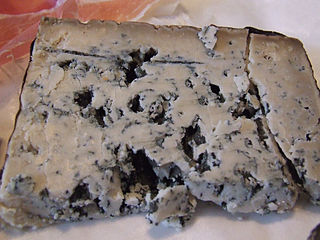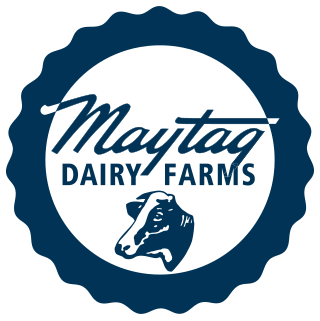
Brie is a soft cow's-milk cheese named after Brie, the French region from which it originated. It is pale in color with a slight grayish tinge under a rind of white mould. The rind is typically eaten, with its flavor depending largely upon the ingredients used and its manufacturing environment. It is similar to Camembert, which is native to a different region of France. Brie typically contains between 60% and 75% butterfat, slightly higher than Camembert.

Cottage cheese is a curdled milk product with a mild flavor and a creamy, heterogeneous, soupy texture. It is made from skimmed milk by draining curds but retaining some of the whey and keeping the curds loose. An essential step in the manufacturing process distinguishing cottage cheese from other fresh cheeses is the addition of a "dressing" to the curd grains, usually cream, which is mainly responsible for the taste of the product. Cottage cheese is not aged.

Cabrales is a blue cheese made in the artisan tradition by rural dairy farmers in Asturias, Spain. This cheese can be made from pure, unpasteurized cow’s milk or blended in the traditional manner with goat and/or sheep milk, which lends the cheese a stronger, spicier flavor.

Goat cheese, goat's cheese or chèvre is cheese made from goat's milk. Goats were among the first animals to be domesticated for producing food. Goat cheese is made around the world with a variety of recipes, giving many different styles of cheeses, from fresh and soft to aged and hard.

Blue cheese is any of a wide range of cheeses made with the addition of cultures of edible molds, which create blue-green spots or veins through the cheese. Blue cheeses vary in taste from very mild to strong, and from slightly sweet to salty or sharp; in colour from pale to dark; and in consistency from liquid or very soft to firm or hard. They may have a distinctive smell, either from the mold or from various specially cultivated bacteria such as Brevibacterium linens.

Maytag Dairy Farms, based in Newton, Iowa USA, is a manufacturer of blue cheese and other food products.

Cotija is an aged Mexican cheese made from cow's milk and named after the town of Cotija, Michoacán. White in color and firm in texture, its flavor is salty and milky. "Young" cotija cheese has been described as akin to a mild feta, while aged (añejo) cotija is more comparable in flavor to hard, aged cheeses like Parmesan. Cotija softens when exposed to heat, but does not melt. Made between the summer and fall seasons; this cheese is made with milk from local cattle and is salted before the fermentation process. The manufacturing processes of most cheeses in Mexico are still rustic and traditional, similar to the manufacturing process that was used upon its invention. Due to the traditional means of production of dairy products in Mexico some dairy products have a conflicting shelf-life which leads to earlier expiration. However, some studies suggest components in the fermentation of Cotija Cheese are natural preservatives that can extend the shelf-life of Cotija Cheese and other food products as well.

Shropshire Blue is a cow's milk cheese made in the United Kingdom.

Castello is a brand of cheeses produced by Arla Foods amba, a Danish-Swedish agricultural marketing cooperative based in Viby, Aarhus. Worldwide, a variety of cheeses are marketed under the Castello name, including semi soft cheeses, semi hard cheeses, blue cheeses, and cream cheeses.

The cuisine of Minnesota is a type of Midwestern cuisine found throughout the state of Minnesota.
Winchester Cheese Company was an artisan cheese producer in the town of Winchester, California, in Riverside County, Southern California.
Vermont Creamery is a creamery and artisanal cheese and butter-maker in Websterville, Vermont, USA. It was founded in 1984 by business partners Allison Hooper and Bob Reese. Previously known as the Vermont Butter and Cheese Company, the company adopted its current name in 2013.

Beenleigh Blue is a thin-rinded, unpressed soft blue cheese made from pasteurised ewe's milk and vegetarian rennet produced by the Ticklemore Cheese Company in Ashprington, Devon, England. The cheese originated in the 1980s with a limited line by Robin and Sari Congdon, and thereafter became available to consumers throughout the year.
The Caves of Faribault is an artisan cheese company headquartered in Faribault, Minnesota as a division of Swiss Valley Farms. Utilizing sandstone caves to age cheese, the company makes a variety of raw milk products, including several styles of blue cheese, Gouda, and cheddar.
Morcella is a soft ripened cheese, made with pasteurized sheep milk that was produced during Spring or Summer. It is sprinkled with morel mushrooms, which is the state mushroom of Minnesota, that are harvested in Minnesota. Morcella is a semi-soft cheese with a creamy texture, strong aroma, and an earthy flavor. It is made by Shepherd's Way farms, which is located in Southern Minnesota. It is sold in grocery stores located in Minnesota such as Kowalski's, and Lunds and Byerlys. It is also sold in the Mill City farmers market and St. Paul farmers market. It is a seasonal cheese that can only be purchased during the season of September. Morcella often gets overwhelming to its strong aromas and should only be eaten with crusty bread.
Big Woods Blue is an artisan blue cheese made with pasteurized sheep milk. It is creamy, firm, and has a complex, spicy flavor. It is aged 6–8 months. It is made by Shepherd's Way farms, which is located in Southern Minnesota. It is sold in grocery stores located in Minnesota such as Kowalski's, and Lunds and Byerlys. It is also sold in the Mill City farmers market and St. Paul farmers market. It was named after Big Woods state park, Minnesota.











